Analysis of a Preliminary Design Approach for Conformal Lattice Structures
Abstract
:Featured Application
Abstract
1. Introduction
2. Materials and Methods
2.1. NURBS Free-Form Deformation Approach for Conformal Wireframe
- A regular wireframe based on the repetition along the X-, Y-, and Z-axis is generated. The number of instances is 14 cells along the Z-direction, 10 cells along the X-direction, and 4 cells along Y-direction for the BC, BCC, and WG. However, for the DA, the instances along the X-direction are 6 to maintain the aspect ratio (Figure 3a);
- A 3D NURBS volume is built around the wireframe using the Cage-Edit command. In the case study, the cage is governed by 5 control points in X-direction, 2 control points in Y-direction, and 3 control points in Z-direction (Figure 3b).
2.2. Structural Size Optimization
2.3. Beam Approach for Linear Structural Analysis
- Karamba3D (1.3.3) plug-in with Rhinoceros 7 (7.8.2) [54]. Karamba3D is a parametric structural engineering tool that performs structural analyses of spatial trusses, frames, and shells, and it is fully embedded in the parametric environment of Grasshopper, the visual programming language inside Rhinoceros. This makes it easy to combine parameterized geometric models, finite element analyses, and optimization algorithms. Karamba3D has been mostly used in the early stage design [65];
- MSC Patran/Nastran [47]. Patran is a pre-/post-processing software for FEA that provides modeling, meshing, analysis setup, and post processing for solvers. Nastran is a multidisciplinary structural solver for accurate static, dynamic, and thermal analyses;
- Ansys 2020 R1 Mechanical [44]. Ansys is an FEA software tool for multidisciplinary simulation with a common platform, ANSYS Workbench, that can connect the tools together. As for Nastran, ANSYS Mechanical is the dedicated tool for multidisciplinary structural analyses.
- The node coordinates list contains the cartesian coordinates of all the nodes of the structure;
- The beam connection list contains the indexes of the starting and ending node of each beam of the structure;
- The beam size list contains the diameter of the cross-section of each beam of the structure.
- The load, constraints, and material are added inside the CAE environment and correspond to the boundary conditions of the structural size optimization (Figure 4):
- Two load cases: 7.5 kN (traction) and -10 kN (compression) applied to the nodes of the beams connected to the big rod’s end;
- The displacements along the X- and Y-direction of the nodes of the beams connected to the big rod’s end are locked;
- The displacements and rotations of the nodes of the beams connected to the small rod’s end are locked;
- Material: AlSi10Mg (Table 2).
3. Results and Discussions
3.1. Conformal Wireframe Modeling
3.2. Structural Size Optimization
3.3. Structural Analysis Validation
4. Conclusions
Author Contributions
Funding
Institutional Review Board Statement
Informed Consent Statement
Data Availability Statement
Acknowledgments
Conflicts of Interest
References
- Rosen, D.W. Computer-Aided Design for Additive Manufacturing of Cellular Structures. Comput. Des. Appl. 2007, 4, 585–594. [Google Scholar] [CrossRef]
- Gibson, I.; Rosen, D.; Stucker, B.; Khorasani, M. Additive Manufacturing Technologies. Addit. Manuf. Technol. 2021. [Google Scholar] [CrossRef]
- Ashby, M.F. Materials Selection in Mechanical Design, 4th ed.; Butterworth Heinemann: Oxford, UK, 2010; ISBN 978-1-85617-663-7. [Google Scholar]
- Ashby, M.F. The properties of foams and lattices. Philos. Trans. R. Soc. A Math. Phys. Eng. Sci. 2006, 364, 15–30. [Google Scholar] [CrossRef]
- Mueller, J.; Matlack, K.H.; Shea, K.; Daraio, C. Energy Absorption Properties of Periodic and Stochastic 3D Lattice Materials. Adv. Theory Simul. 2019, 2, 1900081. [Google Scholar] [CrossRef] [Green Version]
- Syam, W.P.; Jianwei, W.; Zhao, B.; Maskery, I.; Elmadih, W.; Leach, R. Design and analysis of strut-based lattice structures for vibration isolation. Precis. Eng. 2018, 52, 494–506. [Google Scholar] [CrossRef]
- Fleck, N.A.; Deshpande, V.S.; Ashby, M.F. Micro-architectured materials: Past, present and future. Proc. R. Soc. A Math. Phys. Eng. Sci. 2010, 466, 2495–2516. [Google Scholar] [CrossRef]
- Wallach, J.; Gibson, L. Mechanical behavior of a three-dimensional truss material. Int. J. Solids Struct. 2001, 38, 7181–7196. [Google Scholar] [CrossRef]
- Savio, G.; Rosso, S.; Meneghello, R.; Concheri, G. Geometric Modeling of Cellular Materials for Additive Manufacturing in Biomedical Field: A Review. Appl. Bionics Biomech. 2018, 2018, 1–14. [Google Scholar] [CrossRef] [PubMed] [Green Version]
- Pan, C.; Han, Y.; Lu, J. Design and Optimization of Lattice Structures: A Review. Appl. Sci. 2020, 10, 6374. [Google Scholar] [CrossRef]
- Benedetti, M.; du Plessis, A.; Ritchie, R.; Dallago, M.; Razavi, S.; Berto, F. Architected cellular materials: A review on their mechanical properties towards fatigue-tolerant design and fabrication. Mater. Sci. Eng. R Rep. 2021, 144, 100606. [Google Scholar] [CrossRef]
- Zhu, H.; Hobdell, J.; Windle, A. Effects of cell irregularity on the elastic properties of open-cell foams. Acta Mater. 2000, 48, 4893–4900. [Google Scholar] [CrossRef]
- Wu, J.; Wang, W.; Gao, X. Design and Optimization of Conforming Lattice Structures. IEEE Trans. Vis. Comput. Graph. 2021, 27, 43–56. [Google Scholar] [CrossRef] [Green Version]
- Dal Fabbro, P.; Rosso, S.; Ceruti, A.; Meneghello, R.; Concheri, G.; Savio, G. Conformal lattice structures: Modeling and optimization. Design Tools and Methods in Industrial Engineering II: Proceedings of the Second International Conference on Design Tools and Methods in Industrial Engineering, ADM 2021, 9–10 September 2021, Rome, Italy. Lect. Notes Mech. Eng. 2022. [Google Scholar] [CrossRef]
- Wang, H.; Chen, Y.; Rosen, D.W. A Hybrid Geometric Modeling Method for Large Scale Conformal Cellular Structures. In Proceedings of the International Design Engineering Technical Conferences and Computers and Information in Engineering Conference, Long Beach, CA, USA, 24–28 September 2005; Volume 47403, pp. 421–427. [Google Scholar] [CrossRef] [Green Version]
- Chen, Y. 3D Texture Mapping for Rapid Manufacturing. Comput. Des. Appl. 2007, 4, 761–771. [Google Scholar] [CrossRef] [Green Version]
- Calladine, C. Buckminster Fuller’s “Tensegrity” structures and Clerk Maxwell’s rules for the construction of stiff frames. Int. J. Solids Struct. 1978, 14, 161–172. [Google Scholar] [CrossRef]
- Gibson, L.J.; Ashby, M.F. Ashby, Cellular Solids; Cambridge University Press: Cambridge, UK, 1997. [Google Scholar] [CrossRef]
- Maconachie, T.; Leary, M.; Lozanovski, B.; Zhang, X.Z.; Qian, M.; Faruque, O.; Brandt, M. SLM lattice structures: Properties, performance, applications and challenges. Mater. Des. 2019, 183, 108137. [Google Scholar] [CrossRef]
- Kaur, M.; Yun, T.G.; Han, S.M.; Thomas, E.L.; Kim, W.S. 3D printed stretching-dominated micro-trusses. Mater. Des. 2017, 134, 272–280. [Google Scholar] [CrossRef]
- Kirsch, U. (Ed.) Problem Statement—Structural Optimization: Fundamentals and Applications; Springer: Berlin/Heidelberg, Germany, 1993; pp. 1–56. [Google Scholar]
- Mantovani, S.; Campo, G.; Giacalone, M. Steering column support topology optimization including lattice structure for metal additive manufacturing. Proc. Inst. Mech. Eng. Part C J. Mech. Eng. Sci. 2020, 095440622094712. [Google Scholar] [CrossRef]
- Bacciaglia, A.; Ceruti, A.; Liverani, A. Surface smoothing for topological optimized 3D models. Struct. Multidiscip. Optim. 2021, 64, 3453–3472. [Google Scholar] [CrossRef]
- nTopology. 2021. Available online: www.ntopology.com (accessed on 30 June 2021).
- Siemens. 2021. Available online: www.plm.automation.siemens.com/global/it/products/mechanical-design/design-for-additive-manufacture.html (accessed on 30 June 2021).
- Nieto, D.; Sánchez, D. Design for Additive Manufacturing: Tool Review and a Case Study. Appl. Sci. 2021, 11, 1571. [Google Scholar] [CrossRef]
- Thompson, M.K.; Moroni, G.; Vaneker, T.; Fadel, G.; Campbell, R.I.; Gibson, I.; Bernard, A.; Schulz, J.; Graf, P.; Ahuja, B.; et al. Design for Additive Manufacturing: Trends, opportunities, considerations, and constraints. CIRP Ann. 2016, 65, 737–760. [Google Scholar] [CrossRef] [Green Version]
- Pasko, A.; Fryazinov, O.; Vilbrandt, T.; Fayolle, P.-A.; Adzhiev, V. Procedural function-based modelling of volumetric microstructures. Graph. Model. 2011, 73, 165–181. [Google Scholar] [CrossRef] [Green Version]
- Sola, A.; Defanti, S.; Mantovani, S.; Merulla, A.; Denti, L. Technological Feasibility of Lattice Materials by Laser-Based Powder Bed Fusion of A357.0. 3D Print. Addit. Manuf. 2020, 7, 1–7. [Google Scholar] [CrossRef] [Green Version]
- Savio, G.; Meneghello, R.; Concheri, G. Geometric modeling of lattice structures for additive manufacturing. Rapid Prototyp. J. 2018, 24, 351–360. [Google Scholar] [CrossRef]
- Savio, G.; Meneghello, R.; Rosso, S.; Concheri, G. 3D Model Representation and Data Exchange for Additive Manufacturing. Lect. Notes Mech. Eng. 2019, 3, 412–421. [Google Scholar] [CrossRef]
- Liang, Y.; Zhao, F.; Yoo, D.-J.; Zheng, B. Design of conformal lattice structures using the volumetric distance field based on parametric solid models. Rapid Prototyp. J. 2020, 26, 1005–1017. [Google Scholar] [CrossRef]
- Nguyen, J.; Park, S.I.; Rosen, D.W.; Folgar, L.; Williams, J. Conformal lattice structure design and fabrication. In Proceedings of the 23rd Annual International Solid Freeform Fabrication Symposium—An Additive Manufacturing Conference SFF, Austin, TX, USA, 6–8 August 2012; pp. 138–161. [Google Scholar]
- Weeger, O.; Boddeti, N.; Yeung, S.-K.; Kaijima, S.; Dunn, M.L. Digital design and nonlinear simulation for additive manufacturing of soft lattice structures. Addit. Manuf. 2019, 25, 39–49. [Google Scholar] [CrossRef]
- Tamburrino, F.; Graziosi, S.; Bordegoni, M. The Design Process of Additively Manufactured Mesoscale Lattice Structures: A Review. J. Comput. Inf. Sci. Eng. 2018, 18, 040801. [Google Scholar] [CrossRef]
- Sederberg, T.W.; Parry, S.R. Free-form deformation of solid geometric models. In Proceedings of the 13th Annual Conference on Computer Graphics and Interactive Techniques—SIGGRAPH ’86, Dallas, TX, USA, 31 August 1986; ACM Press: New York, NY, USA, 1986; Volume 20, pp. 151–160. [Google Scholar]
- Coquillart, S. Extended free-form deformation: A sculpturing tool for 3D geometric modeling. In Proceedings of the 17th Annual Conference on Information Technology Education, Dallas TX, USA, 1 September 1990; ACM Press: New York, NY, USA, 1990; Volume 24, pp. 187–196. [Google Scholar]
- Lamousin, H.; Waggenspack, N. NURBS-based free-form deformations. IEEE Eng. Med. Boil. Mag. 1994, 14, 59–65. [Google Scholar] [CrossRef]
- Proch, J. Free Form Deformation Methods—The Theory and Practice. In Proceedings of the 16th Conference on Applied Mathematics-APLIMAT 2017, Bratislava, Slovak republic, 31 January–2 February 2017. [Google Scholar]
- Zhang, Y.; Zheng, J.; Cai, Y. Proxy-driven free-form deformation by topology-adjustable control lattice. Comput. Graph. 2020, 89, 167–177. [Google Scholar] [CrossRef]
- Kalamkarov, A.L.; Andrianov, I.V.; Danishevskyy, V. Asymptotic Homogenization of Composite Materials and Structures. Appl. Mech. Rev. 2009, 62, 030802. [Google Scholar] [CrossRef]
- Savio, G.; Curtarello, A.; Rosso, S.; Meneghello, R.; Concheri, G. Homogenization driven design of lightweight structures for additive manufacturing. Int. J. Interact. Des. Manuf. 2019, 13, 263–276. [Google Scholar] [CrossRef]
- Ahmadi, S.; Campoli, G.; Yavari, S.A.; Sajadi, B.; Wauthle, R.; Schrooten, J.; Weinans, H.; Zadpoor, A.A. Mechanical behavior of regular open-cell porous biomaterials made of diamond lattice unit cells. J. Mech. Behav. Biomed. Mater. 2014, 34, 106–115. [Google Scholar] [CrossRef]
- Ptochos, E.; Labeas, G. Elastic modulus and Poisson’s ratio determination of micro-lattice cellular structures by analytical, numerical and homogenisation methods. J. Sandw. Struct. Mater. 2012, 14, 597–626. [Google Scholar] [CrossRef]
- Bacciaglia, A.; Ceruti, A.; Liverani, A. A systematic review of voxelization method in additive manufacturing. Mech. Ind. 2019, 20, 630. [Google Scholar] [CrossRef] [Green Version]
- Rakowski, J. The interpretation of the shear locking in beam elements. Comput. Struct. 1990, 37, 769–776. [Google Scholar] [CrossRef]
- Bacciaglia, A.; Ceruti, A.; Liverani, A. Structural Analysis of Voxel-Based Lattices Using 1D Approach. 3D Print. Addit. Manuf. 2021. [Google Scholar] [CrossRef]
- Ravari, M.K.; Kadkhodaei, M.; Badrossamay, M.; Rezaei, R. Numerical investigation on mechanical properties of cellular lattice structures fabricated by fused deposition modeling. Int. J. Mech. Sci. 2014, 88, 154–161. [Google Scholar] [CrossRef]
- Campoli, G.; Borleffs, M.; Yavari, S.A.; Wauthle, R.; Weinans, H.; Zadpoor, A.A. Mechanical properties of open-cell metallic biomaterials manufactured using additive manufacturing. Mater. Des. 2013, 49, 957–965. [Google Scholar] [CrossRef]
- Genovese, K.; Leeflang, S.; Zadpoor, A.A. Microscopic full-field three-dimensional strain measurement during the mechanical testing of additively manufactured porous biomaterials. J. Mech. Behav. Biomed. Mater. 2017, 69, 327–341. [Google Scholar] [CrossRef]
- Dong, G.; Zhao, Y.F. Numerical and experimental investigation of the joint stiffness in lattice structures fabricated by additive manufacturing. Int. J. Mech. Sci. 2018, 148, 475–485. [Google Scholar] [CrossRef]
- Jin, X.; Li, G.-X.; Zhang, M. Design and optimization of nonuniform cellular structures. Proc. Inst. Mech. Eng. Part C J. Mech. Eng. Sci. 2017, 232, 1280–1293. [Google Scholar] [CrossRef]
- Concli, F.; Gilioli, A. Numerical and experimental assessment of the mechanical properties of 3D printed 18-Ni300 steel trabecular structures produced by Selective Laser Melting—A lean design approach. Virtual Phys. Prototyp. 2019, 14, 267–276. [Google Scholar] [CrossRef]
- Rosso, S.; Savio, G.; Uriati, F.; Meneghello, R.; Concheri, G. Optimization Approaches in Design for Additive Manufacturing. Proc. Des. Soc. Int. Conf. Eng. Des. 2019, 1, 809–818. [Google Scholar] [CrossRef] [Green Version]
- Rosso, S.; Uriati, F.; Grigolato, L.; Meneghello, R.; Concheri, G.; Savio, G. An Optimization Workflow in Design for Additive Manufacturing. Appl. Sci. 2021, 11, 2572. [Google Scholar] [CrossRef]
- Savio, G.; Gaggi, F.; Meneghello, R.; Concheri, G. Design method and taxonomy of optimized regular cellular structures for additive manufacturing technologies. In Proceedings of the 20th International Conference on Engineering Design (ICED 15), Milan, Italy, 27–30 July 2015; pp. 235–244. Available online: https://www.designsociety.org/publication/37788/design_method_and_taxonomy_of_optimized_regular_cellular_structures_for_additive_manufacturing_technologies (accessed on 29 November 2021).
- Preisinger, C. Linking Structure and Parametric Geometry. Arch. Des. 2013, 83, 110–113. [Google Scholar] [CrossRef]
- BSI. Bs en 1993-1-1: 2005: Eurocode 3. design of steel structures. general rules and rules for buildings, European Committee for Standardization, Brussel, BE, 2005. Available online: https://www.phd.eng.br/wp-content/uploads/2015/12/en.1993.1.1.2005.pdf (accessed on 29 November 2021).
- ISO/ASTM 52900:2015. Additive Manufacturing-General Principles-Terminology; ISO International Organization for Standardization: Geneva, Switzerland; ASTM American Society for Testing and Materials: West Conshohocken, PA, USA, 2015. [Google Scholar]
- Yap, C.Y.; Chua, C.K.; Dong, Z.; Liu, Z.H.; Zhang, D.Q.; Loh, L.E.; Sing, S.L. Review of selective laser melting: Materials and applications. Appl. Phys. Rev. 2015, 2, 041101. [Google Scholar] [CrossRef]
- Frazier, W.E. Metal Additive Manufacturing: A Review. J. Mater. Eng. Perform. 2014, 23, 1917–1928. [Google Scholar] [CrossRef]
- Wohlers, I.; Campbell, O.; Diegel, J.; Kowen, T. Caffrey, Wohlers Report 2019; Wohlers Associates, Inc.: Fort Collins, CO, USA, 2019; ISBN 978-0-9913332-5-7. [Google Scholar]
- Renishaw, AlSi10Mg-0403 Powder for Additive Manufacturing. 2015. Available online: www.renishaw.it/it/schede-tecniche-produzione-additiva--17862 (accessed on 29 November 2021).
- Weaver, J.M.; Barton, T.; Linn, J.; Jenkins, D.; Miles, M.P.; Smith, R. Quantifying accuracy of a concept laser metal additive machine through the NIST test artifact. Rapid Prototyp. J. 2019, 25, 221–231. [Google Scholar] [CrossRef]
- Mäenpää, J. Algorithm-Aided Structural Engineering of Steel-Framed Warehouse. Master’s Thesis, Tampere University of Technology, Tampere, Finland, January 2018. [Google Scholar]
- Wang, C. Timoshenko Beam-Bending Solutions in Terms of Euler-Bernoulli Solutions. J. Eng. Mech. 1995, 121, 763–765. [Google Scholar] [CrossRef]
- Madenci, E.; Özkılıç, Y.O.; Gemi, L. Buckling and free vibration analyses of pultruded GFRP laminated composites: Experimental, numerical and analytical investigations. Compos. Struct. 2020, 254, 112806. [Google Scholar] [CrossRef]
- Khdeir, A.; Reddy, J. Free vibration of cross-ply laminated beams with arbitrary boundary conditions. Int. J. Eng. Sci. 1994, 32, 1971–1980. [Google Scholar] [CrossRef]
- Gemi, L.; Madenci, E.; Özkılıç, Y.O. Experimental, analytical and numerical investigation of pultruded GFRP composite beams infilled with hybrid FRP reinforced concrete. Eng. Struct. 2021, 244, 112790. [Google Scholar] [CrossRef]
- Wang, X.D.; Shi, G. Boundary Layer Solutions Induced by Displacement Boundary Conditions of Shear Deformable Beams and Accuracy Study of Several Higher-Order Beam Theories. J. Eng. Mech. 2012, 138, 1388–1399. [Google Scholar] [CrossRef]
- Madenci, E.; Gülcü, Ş. Optimization of flexure stiffness of FGM beams via artificial neural networks by mixed FEM. Struct. Eng. Mech. 2020, 75, 633–642. [Google Scholar] [CrossRef]
- Madenci, E. Free vibration analysis of carbon nanotube RC nanobeams with variational approaches. Adv. Nano Res. 2021, 11, 157–171. [Google Scholar]
- ANSYS. ANSYS Help. 2021. Available online: https://ansyshelp.ansys.com/account/secured?returnurl=/Views/Secured/corp/v190/wb_sim/ds_Beam_Tool.html?q=beam tool (accessed on 30 June 2021).
- Preisinger, C. Karamba3D Manual. 2021. Available online: https://manual.karamba3d.com/3-in-depth-component-reference/3.6-results/3.6.6-utilization-of-elements (accessed on 30 June 2021).
- Guo, X.; Zheng, X.; Yang, Y.; Yang, X.; Yi, Y. Mechanical behavior of TPMS-based scaffolds: A comparison between minimal surfaces and their lattice structures, SN. Appl. Sci. 2019, 1, 1–11. [Google Scholar] [CrossRef] [Green Version]
- Savio, G.; Meneghello, R.; Concheri, G. Optimization of lattice structures for additive manufacturing technologies, Advances on Mechanics, Design Engineering and Manufacturing. Lect. Notes Mech. Eng. 2017, 213–222. [Google Scholar] [CrossRef]
- Zienkiewicz, O.C.; Taylor, R.L.; Zhu, J.Z. The Finite Element Method: Its Basics and Foundamentals, 7th ed.; Butterworth Heinemann: Oxford, UK, 2013; ISBN 9780080951355. [Google Scholar]
- Desai, P. Effect of Slenderness Ratio on Euler Critical Load for Elastic Columns with Effect of Slenderness Ratio on Euler Critical Load for Elastic Columns with ANSYS. J. Eng. Res. Appl. 2018, 8, 40–43. [Google Scholar] [CrossRef]
- Ahmadi, S.M.; Yavari, S.A.; Wauthle, R.; Pouran, B.; Schrooten, J.; Weinans, H.; Zadpoor, A.A. Additively Manufactured Open-Cell Porous Biomaterials Made from Six Different Space-Filling Unit Cells: The Mechanical and Morphological Properties. Materials 2015, 8, 1871–1896. [Google Scholar] [CrossRef] [PubMed] [Green Version]
- Jamshidian, M.; Boddeti, N.; Rosen, D.; Weeger, O. Multiscale modelling of soft lattice metamaterials: Micromechanical nonlinear buckling analysis, experimental verification, and macroscale constitutive behaviour. Int. J. Mech. Sci. 2020, 188, 105956. [Google Scholar] [CrossRef]
- Yan, C.; Hao, L.; Hussein, A.; Young, P.; Raymont, D. Advanced lightweight 316L stainless steel cellular lattice structures fabricated via selective laser melting. Mater. Des. 2014, 55, 533–541. [Google Scholar] [CrossRef] [Green Version]
- Hossain, U.; Ghouse, S.; Nai, K.; Jeffers, J.R. Mechanical and morphological properties of additively manufactured SS316L and Ti6Al4V micro-struts as a function of build angle. Addit. Manuf. 2021, 46, 102050. [Google Scholar] [CrossRef] [PubMed]
- Rosso, S.; Meneghello, R.; Concheri, G.; Savio, G. Scale and Shape Effects on the Fatigue Behaviour of Additively Manufactured SS316L Structures: A Preliminary Study. In Lecure notes in Mechanical Engineering. Design Tools and Methods in Industrial Engineering. Proceedings of the International Conference on Design Tools and Methods in Industrial Engineering, ADM 2019, 9–10 September 2019, Modena, Italy. Lect. Notes Mech. Eng. 2020, 879–890. [Google Scholar] [CrossRef]
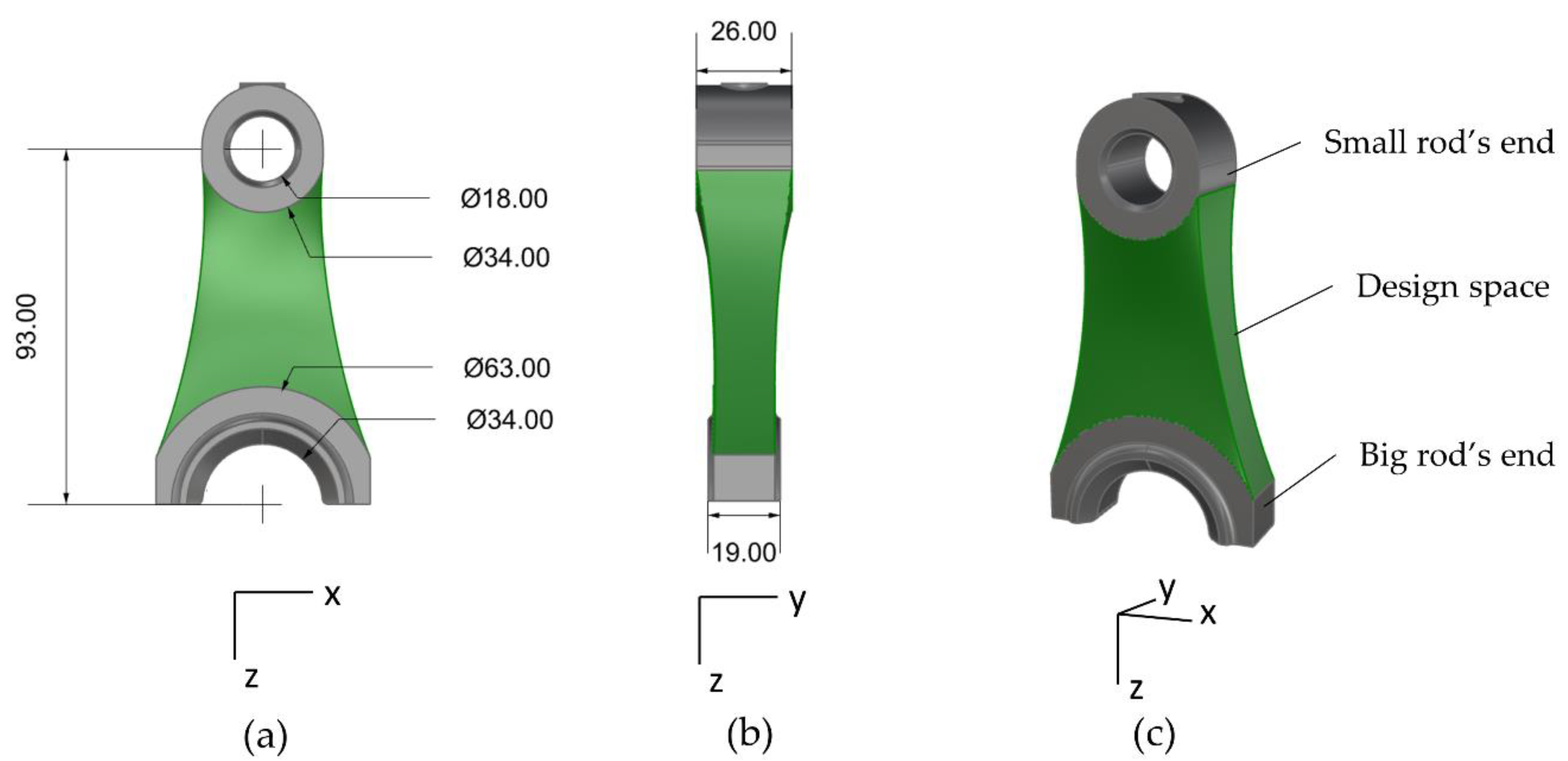

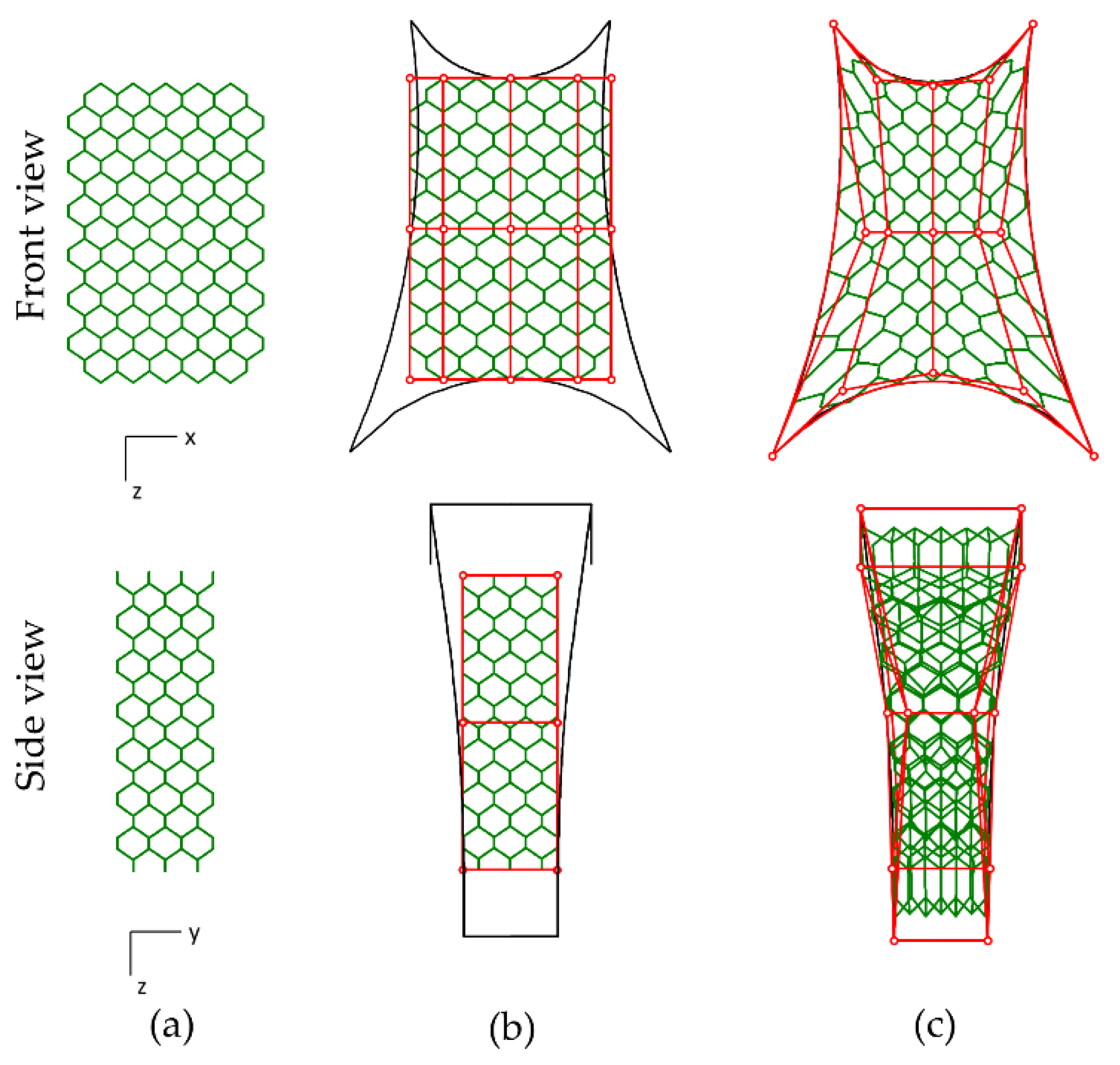



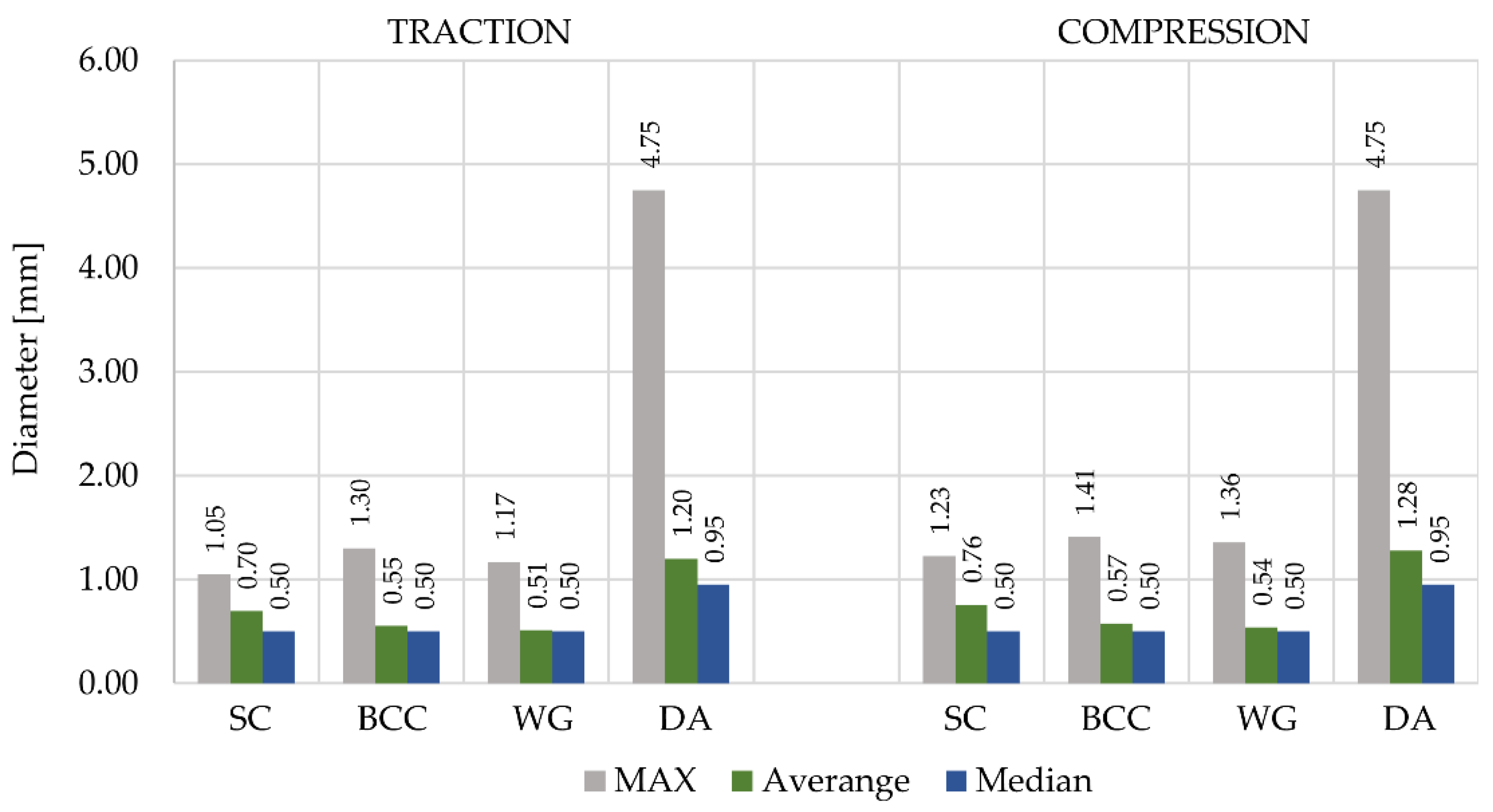

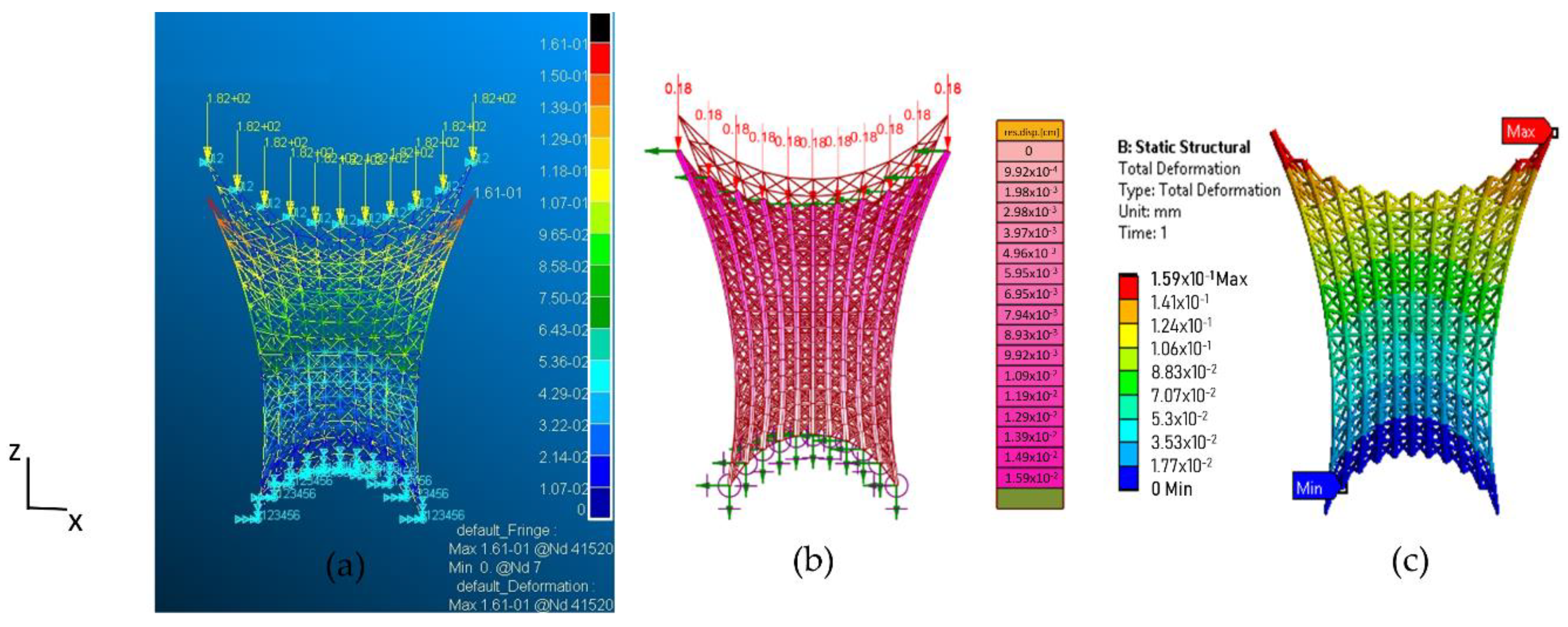
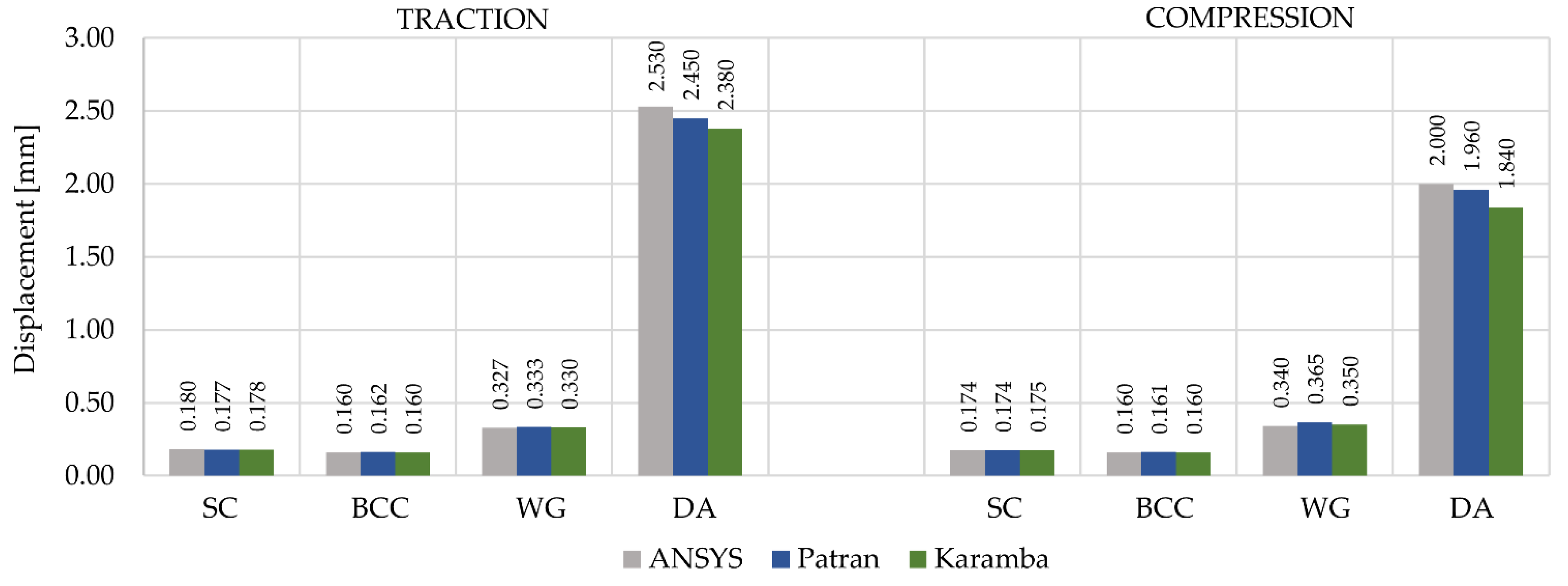
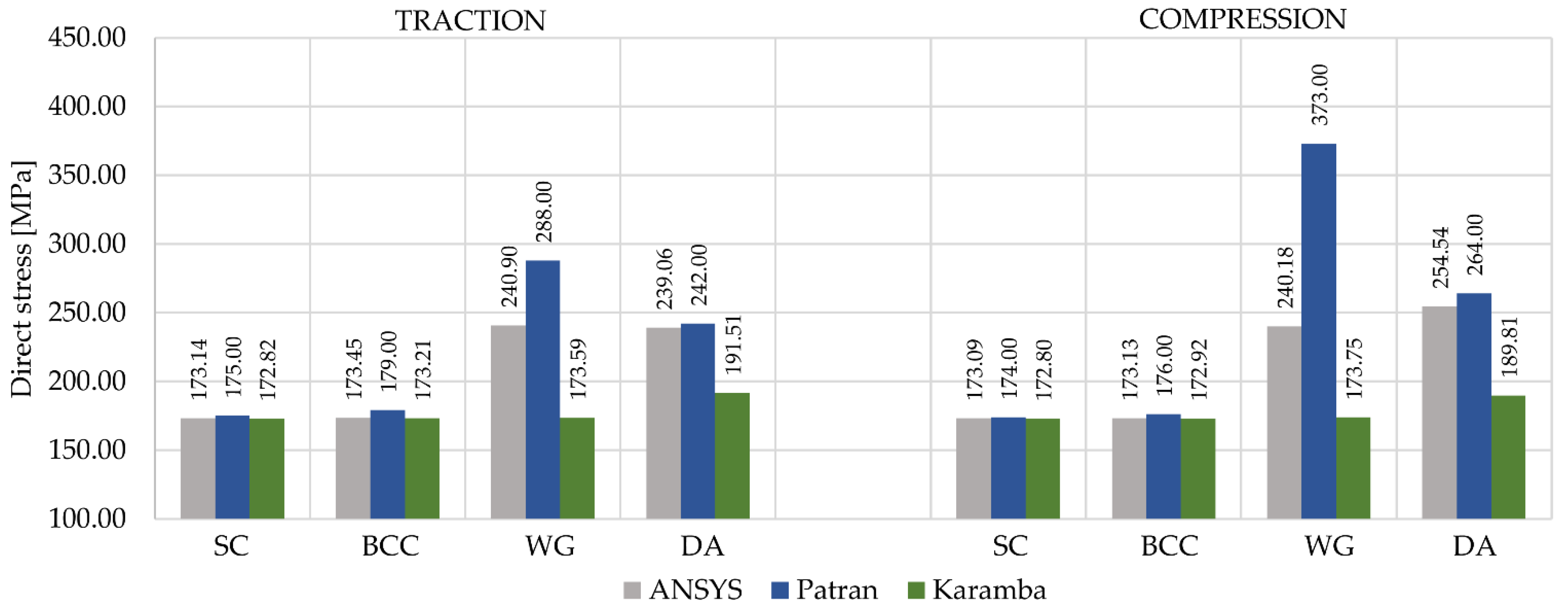
| Lattice Structure Type | Number of Loaded Nodes | Traction Load (for Each Node) [N] | Compression Load (for Each Node) [N] |
|---|---|---|---|
| SC | 55 | 136.36 | −181.82 |
| BCC | 55 | 136.36 | −181.82 |
| WG | 94 | 79.79 | −106.38 |
| DA | 20 | 375.00 | −500.00 |
| Density | 2700 Kg/m3 |
| Young modulus | 68 GPa |
| Yield strength | 190 MPa |
| Ultimate tensile strength | 335 MPa |
| Poisson ratio | 0.30 |
| Lattice Structure Type | Number of Nodes | Number of Beams | Total Beams Length [m] | Maxwell’s Rule |
| SC | 880 | 2141 | 7.86 | Bending-dominated |
| BCC | 1480 | 6937 | 23.27 | Stretching-dominated |
| WG | 3841 | 18,124 | 48.22 | Stretching-dominated |
| DA | 623 | 1078 | 3.96 | Bending-dominated |
Publisher’s Note: MDPI stays neutral with regard to jurisdictional claims in published maps and institutional affiliations. |
© 2021 by the authors. Licensee MDPI, Basel, Switzerland. This article is an open access article distributed under the terms and conditions of the Creative Commons Attribution (CC BY) license (https://creativecommons.org/licenses/by/4.0/).
Share and Cite
Dal Fabbro, P.; Rosso, S.; Ceruti, A.; Boscolo Bozza, D.; Meneghello, R.; Concheri, G.; Savio, G. Analysis of a Preliminary Design Approach for Conformal Lattice Structures. Appl. Sci. 2021, 11, 11449. https://doi.org/10.3390/app112311449
Dal Fabbro P, Rosso S, Ceruti A, Boscolo Bozza D, Meneghello R, Concheri G, Savio G. Analysis of a Preliminary Design Approach for Conformal Lattice Structures. Applied Sciences. 2021; 11(23):11449. https://doi.org/10.3390/app112311449
Chicago/Turabian StyleDal Fabbro, Pierandrea, Stefano Rosso, Alessandro Ceruti, Diego Boscolo Bozza, Roberto Meneghello, Gianmaria Concheri, and Gianpaolo Savio. 2021. "Analysis of a Preliminary Design Approach for Conformal Lattice Structures" Applied Sciences 11, no. 23: 11449. https://doi.org/10.3390/app112311449






